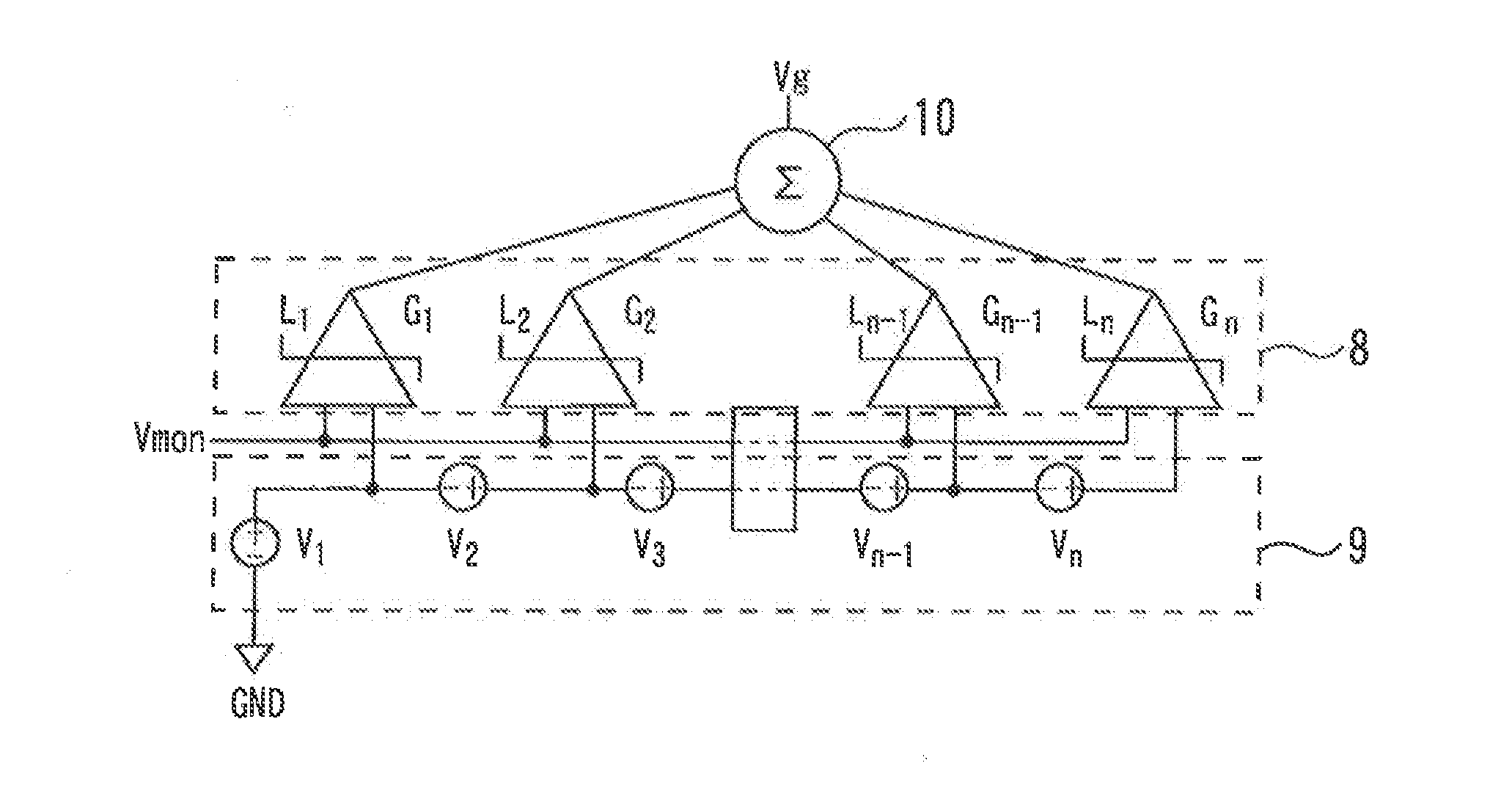Cascode amplifier
- Summary
- Abstract
- Description
- Claims
- Application Information
AI Technical Summary
Benefits of technology
Problems solved by technology
Method used
Image
Examples
first embodiment
[0018]FIG. 1 is a diagram illustrating a cascode amplifier according to a first embodiment of the present invention. A transistor 1 is a source-grounded transistor that has a gate, a grounded source and a drain. A signal is inputted to the gate of the transistor 1 via a DC cut capacitance 2.
[0019]A transistor 3 is a gate-grounded transistor that includes a gate, a source connected to the drain of the transistor 1 and a drain. A load 4 is connected to the drain of the transistor 3. A signal is outputted from the drain of the transistor 3 via a DC cut capacitance 5. The transistors 1 and 3 are silicon MOSFETs.
[0020]A DC-DC converter 5 supplies a supply voltage which is variable according to output power to the drain of the transistor 3 via the load 4. A bias circuit 6 supplies a voltage expressed by a function of the supply voltage to the gate of the transistor 3. A bias circuit 7 supplies a voltage expressed by a function of the supply voltage to the gate of the transistor 1.
[0021]Mo...
second embodiment
[0027]FIG. 4 is a diagram illustrating a cascode amplifier according to a second embodiment of the present invention. A low pass filter 11 is connected between the input of the bias circuit 6 and the drain of the transistor 3. Furthermore, the bias circuit 7 supplies a voltage expressed by a function of the output voltage of the bias circuit 6 to the gate of the transistor 1.
[0028]Since it is difficult to integrate the cascode amplifier and the DC-DC converter 5 on the same chip, they are formed on different chips. Therefore, in the first embodiment, independent terminals to monitor the supply voltage are necessary, which may cause an increase of the chip size of the cascode amplifier and an increase of mounting area when the DC-DC converter 5 is combined. Thus, in the present embodiment, the input of the bias circuit 6 is connected to the drain of the transistor 3. This eliminates the necessity for providing additional terminals and can prevent the chip size and mounting area from ...
third embodiment
[0030]FIG. 5 is a diagram illustrating a cascode amplifier according to a third embodiment of the present invention. A digital interface 12 receives a digital signal from outside and decodes the digital signal. Memories 13 and 14 store digital information inputted from outside. Functions of the bias circuits 6 and 7 are set according to digital information stored in the memories 13 and 14. This allows optimum conditions to be set for control conditions of the DC-DC converter 5 and bias conditions of the cascode amplifier which vary depending on differences in a modulation scheme or the like, making it possible to obtain excellent power added efficiency for various operation conditions.
[0031]FIG. 6 is a diagram illustrating a bias circuit according to the third embodiment of the present invention. A reference voltage Vi (i=1 . . . n), a gain Gi (i=1 . . . n), and a limiting level Li (i=1 . . . n) of each of a plurality of limiter amplifiers 8 and a plurality of reference voltage sour...
PUM
 Login to View More
Login to View More Abstract
Description
Claims
Application Information
 Login to View More
Login to View More - R&D
- Intellectual Property
- Life Sciences
- Materials
- Tech Scout
- Unparalleled Data Quality
- Higher Quality Content
- 60% Fewer Hallucinations
Browse by: Latest US Patents, China's latest patents, Technical Efficacy Thesaurus, Application Domain, Technology Topic, Popular Technical Reports.
© 2025 PatSnap. All rights reserved.Legal|Privacy policy|Modern Slavery Act Transparency Statement|Sitemap|About US| Contact US: help@patsnap.com



